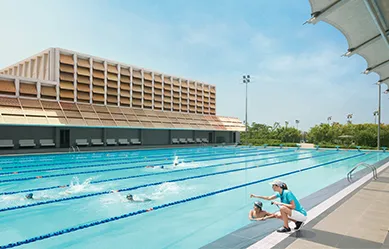- About Us
- Our Impact
-
Our Projects
Residential
- About Lodha
Why Our Cities are Feeling the Heat (And How to Cool Them Down)
By Lodha
August 06, 2025

As urbanisation accelerates, it becomes all the more imperative for nations and urban societies to arrive at sustainable development practices. The Urban Heat Island (UHI) effect has become a significant concern for cities across the globe. Particularly in densely populated regions, understanding and mitigating the effects of Urban Heat Island in India is critical to maintaining livable, healthy, and sustainable cities.
What is the Urban Heat Island Effect?
The Urban Heat Island effect refers to the tendency of urban areas to experience higher temperatures than their surrounding rural areas. In some cases, this difference can be as high as 2 to 5 degrees Celsius.
Factors Contributing to the UHI Effect:
i. Absorption of Heat by Buildings, Roads and Pavements
Materials like concrete and asphalt absorb heat & retain it throughout the day. At night when the outdoor temperatures drop, they release this absorbed heat back into the atmosphere, leading to a slower cooling process in cities compared to rural areas.
ii. Lack of Vegetation and Water Bodies
Urban areas often lack sufficient green spaces in contrast to rural areas which provide shade and promote natural cooling through evapotranspiration, a process in which plants and trees release moisture into the atmosphere, cooling the surrounding air. Water bodies also significantly contribute in cooling the microclimate of the area.
iii. Human Activities
The high concentration of vehicles, air conditioning units, industrial facilities, buildings, and other energy-intensive activities in urban areas emit waste heat, which is a direct contributor to higher urban temperatures.
iv. Building Density
Buildings and high-density developments create “urban canyons,” which trap heat and limit airflow leading to poor ventilation and stagnant, warmer air, particularly in dense city centres.
Impacts of the Urban Heat Island Effect
- Worsened Air Quality
The UHI effect contributes to worsened air quality by promoting the formation of ground-level ozone, a harmful pollutant that intensifies under high temperatures. This increased ozone concentration, combined with other pollutants in urban areas, leads to poor air quality, which directly affects public health. Poor air quality can lead to respiratory problems, increased hospital admissions, and a reduction in overall urban livability with prolonged exposures of the vulnerable communities.
- Disrupted Ecosystems
The UHI effect can alter local ecosystems by creating warmer urban microclimates, negatively affecting wildlife and plant species. Many species are sensitive to temperature changes, and warmer temperatures in cities may shift the balance of local flora and fauna, making it difficult for certain plants and animals to survive leading to the loss of biodiversity. The altered conditions can also disrupt migratory patterns, food chains, and breeding cycles of urban wildlife. Over time, these changes can degrade the ecological health of urban areas, reducing green spaces’ ability to provide ecosystem services like air purification and cooling.
- Health Risks
The UHI effect poses significant health risks, particularly for vulnerable populations including the elderly, children, and individuals with pre-existing health conditions. As urban temperatures rise, heat-related illnesses, such as heatstroke, dehydration, and respiratory problems become more common in urban areas. Prolonged exposure to higher temperatures in cities combined with poor air quality exacerbates these conditions, leading to respiratory conditions like asthma and can trigger cardiovascular issues straining healthcare systems and putting at-risk individuals in greater danger. These health impacts are often more severe in densely populated urban areas, where cooling resources may be limited, and socioeconomic factors can restrict access to adequate healthcare and preventive measures.
- Loss of Employment
In India, 80% of urban workers are employed in the informal sector, with minimal job security and irregular incomes. This precarity, along with pre-existing socio-economic vulnerabilities make these workers – many of whom are engaged in outdoor or labour-intensive jobs – susceptible to the effects of heat waves and its subsequent brunt on their wages and health. Extreme heat can lead to reduced working hours, lower productivity, and even work stoppages, directly impacting daily earnings. Prolonged exposure to high temperatures increases the risk of heat-related illness, such as heatstroke and dehydration, further reducing their capacity to work. As a result, these already vulnerable populations face deeper economic insecurity and worsening socio-economic inequalities.
- Increased Water Demand
As cities heat up, the demand for water—whether for drinking, cooling, or irrigation—increases, putting additional stress on already limited water resources especially in cities that are prone to water scarcity or poor water management.
- Increased Energy Consumption
The Urban Heat Island (UHI) effect significantly raises temperatures in cities, driving up the demand for cooling, particularly through air conditioning. This creates a paradox: while air conditioning is used to counteract rising heat, it also contributes to the problem by releasing waste heat into the environment, further intensifying the UHI effect.
In countries like India, where energy demand is already a critical issue, the Urban Heat Island (UHI) effect presents a significant challenge. India depends heavily on energy imports, and rising energy demand for cooling in urban areas threatens both economic stability and energy security. Finding more efficient ways to cool cities is essential for reducing this energy demand. Promoting UHI mitigating strategies alongside levers of energy-conscious behaviour and expanding the adoption of energy-efficient technologies such as smart cooling systems and advanced building materials, is vital for safeguarding energy security. This is a key factor in supporting sustained economic growth while reducing the negative feedback loop of the UHI effect.
What can we as developers do to mitigate this phenomenon?
The Urban Heat Island (UHI) effect is a well-known consequence of rapid urbanisation, but it doesn’t have to be a permanent challenge for a city-dweller. Developers play a critical role in addressing this issue by adopting thoughtful design and construction practices that not only minimise the UHI effect but also create more sustainable and resilient communities. With the focus on sustainability at Lodha, we have taken proactive steps to mitigate this phenomenon at Palava City, demonstrating how innovative urban planning can lead to cooler, more liveable environments.
- Use of Reflective Materials and Paint: One of the most effective ways to reduce heat absorption is through the use of reflective materials. At Palava, we apply special paints and materials with a high Solar Reflective Index (SRI) on rooftops and exterior surfaces to minimise heat gain. This keeps buildings naturally cooler, reducing the need for artificial cooling and thus, reducing the burden on energy consumption.
- Enhanced Green Covers: A key component of our UHI mitigation strategy has been large-scale reforestation. At Palava City, we’ve planted over 32,000 trees, encompassing around 120 species, along with a wide variety of shrubs, grasses, creepers, and palms. These green spaces not only add to the city’s beauty but also provide essential cooling, with tree canopies significantly lowering temperatures compared to areas dominated by asphalt and concrete.
- Water Bodies for Enhanced Microclimate: Incorporating water features, such as fountains, ponds, or urban wetlands, plays a crucial role in mitigating the Urban Heat Island effect by creating cooler microclimates. Water bodies naturally absorb heat during the day and release it more slowly than paved surfaces, which helps to lower temperatures in surrounding areas. At Lodha, we prioritise integrating such water features into our developments, ensuring that they are strategically placed to maximise their cooling impact. This approach not only enhances the aesthetic appeal of our projects but also contributes to a more comfortable and livable urban environment.
- Urban Design and Layout: By strategically designing the layout of city blocks and homes, we maximise natural ventilation through breeze and air flow reducing the canyon effect. Furthermore, the presence of multiple courtyards – naturally shaded spaces for residents, contribute to a cooler environment. Our building orientations are designed to cast shadows on internal roads, reducing heat absorption by the hardscaped roads and creating a more comfortable urban space. Additionally, optimized orientation and Window-to-wall ratios in buildings are carefully considered to enhance cross-ventilation.
It is noteworthy that with meticulous planning and sustainable development strategies at Palava we have been able reduce the land surface temperature of the area by 7 degrees between 2008 and 2023. The maximum land surface temperature in Palava City, is 3 degrees cooler than Kalyan-Dombivli and 2 degrees cooler than Mumbai.
A Vision for Sustainable Cities
The UHI effect may be an inevitable outcome of urbanisation, but through innovative design, thoughtful urban planning, and a commitment to sustainability, we can mitigate its impact. At Lodha, we are dedicated to enhancing urban resilience and sustainability, starting with Palava City. Our goal is to develop cities that are not only cooler and more comfortable but also serve as models of sustainability for future urban centres globally. By prioritising environmental resilience, we can play a pivotal role in shaping sustainable development projects, as well as sustainable cities and communities that thrive in harmony with nature.
You may also like




 Enquire
Enquire
 Call
Call
 chat
chat






